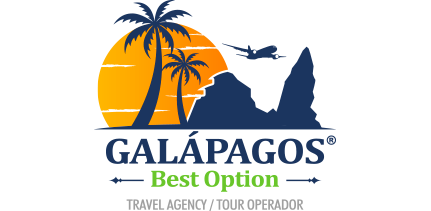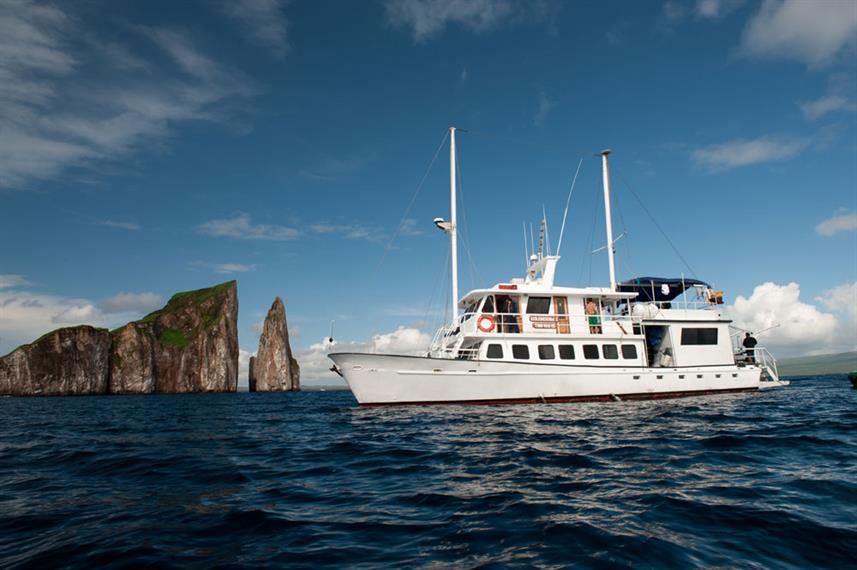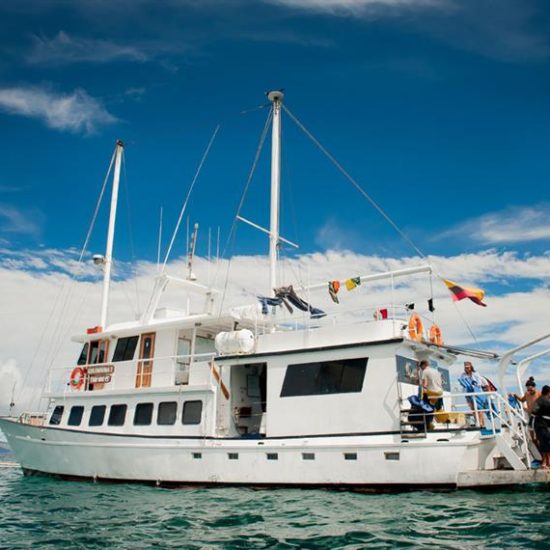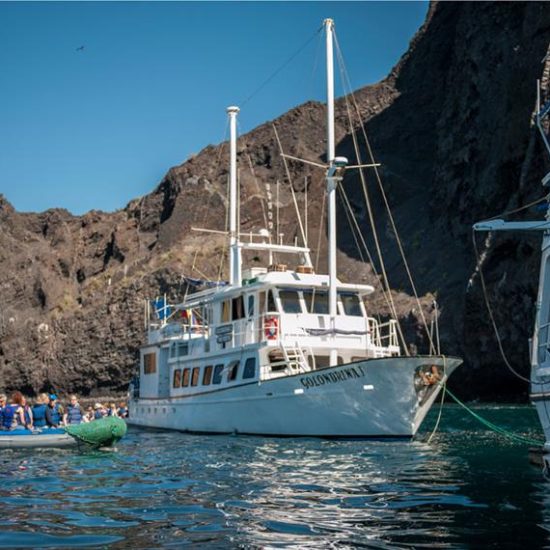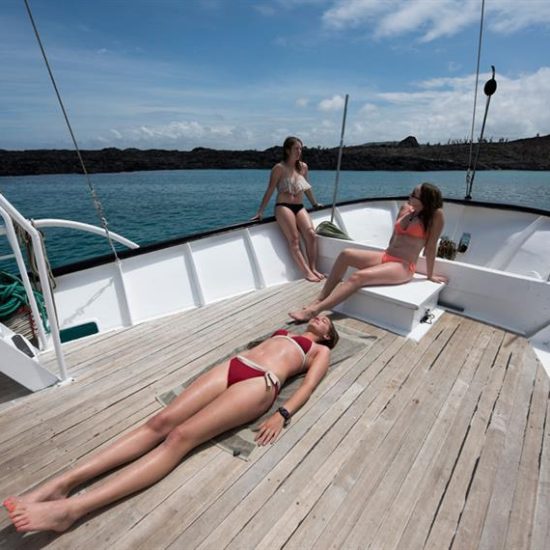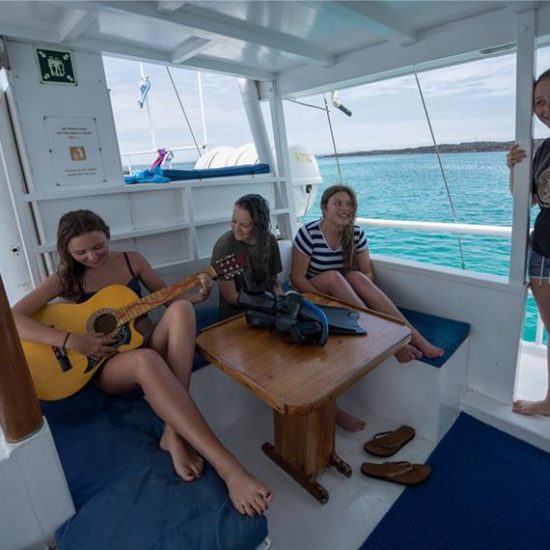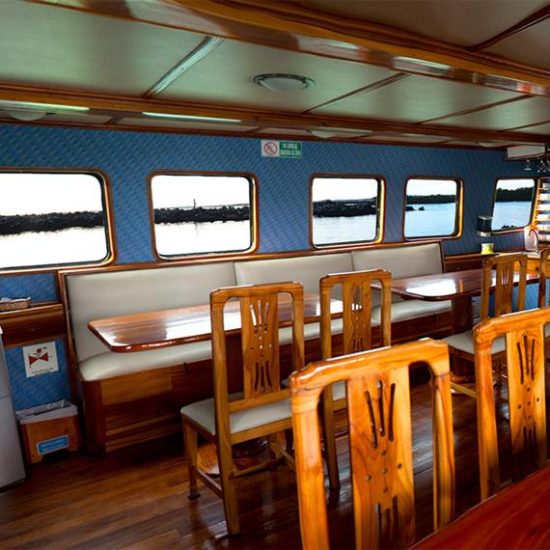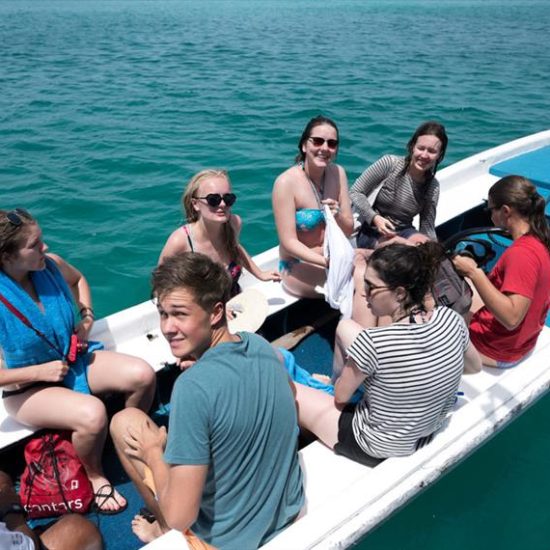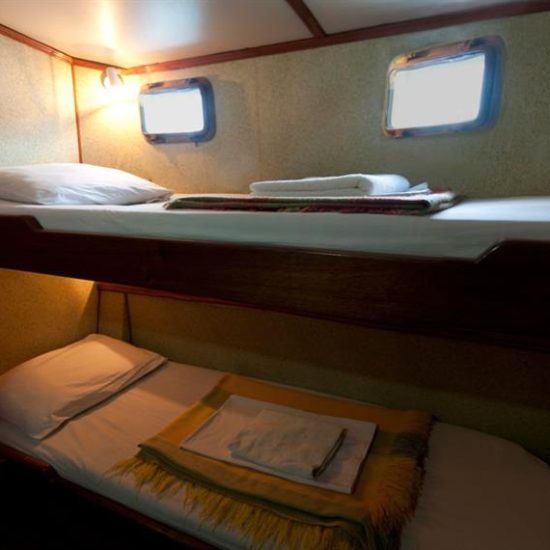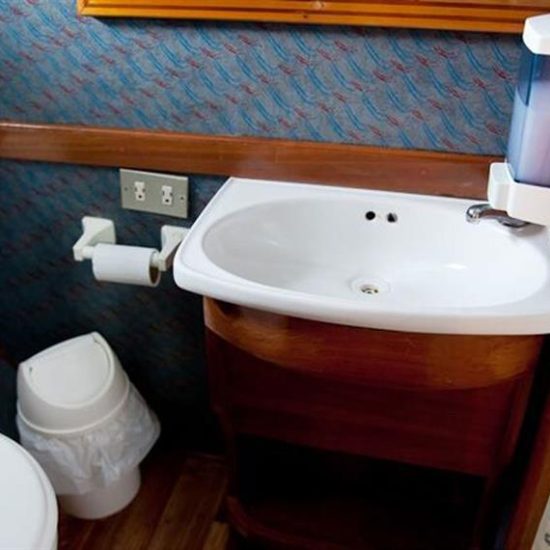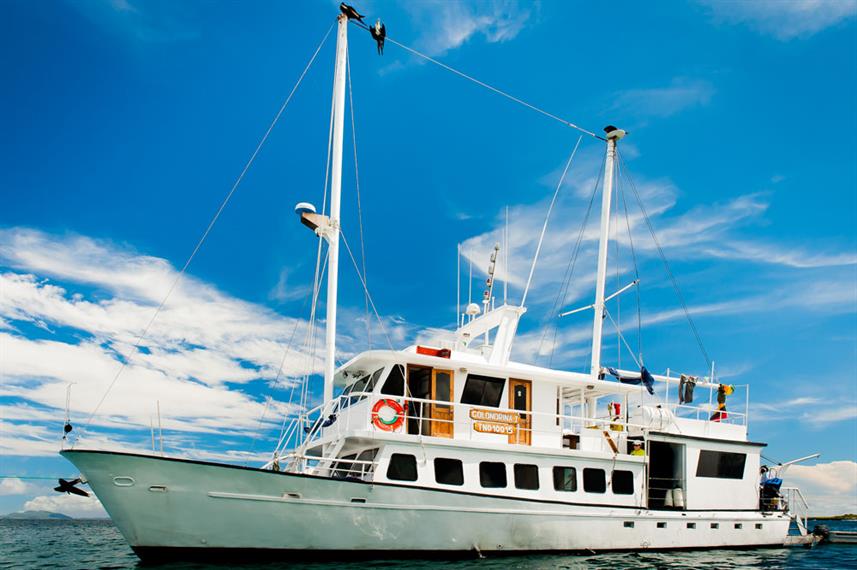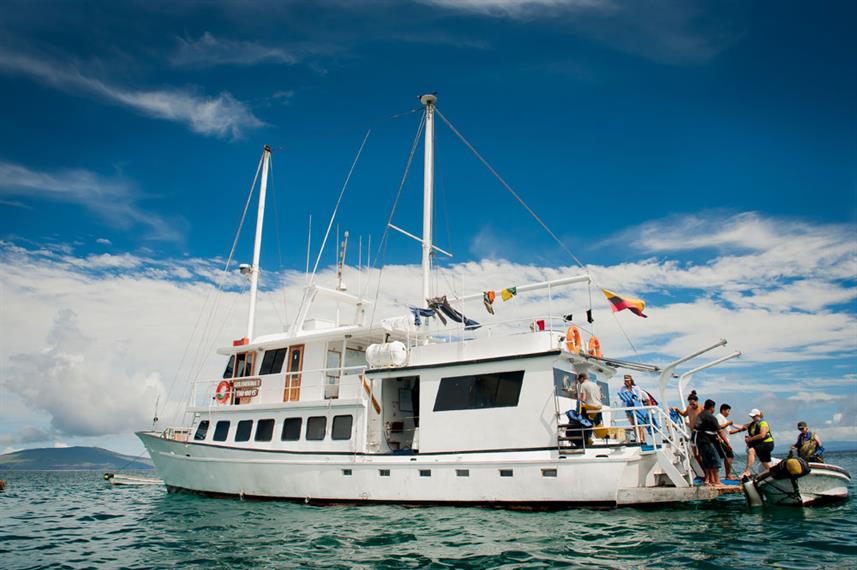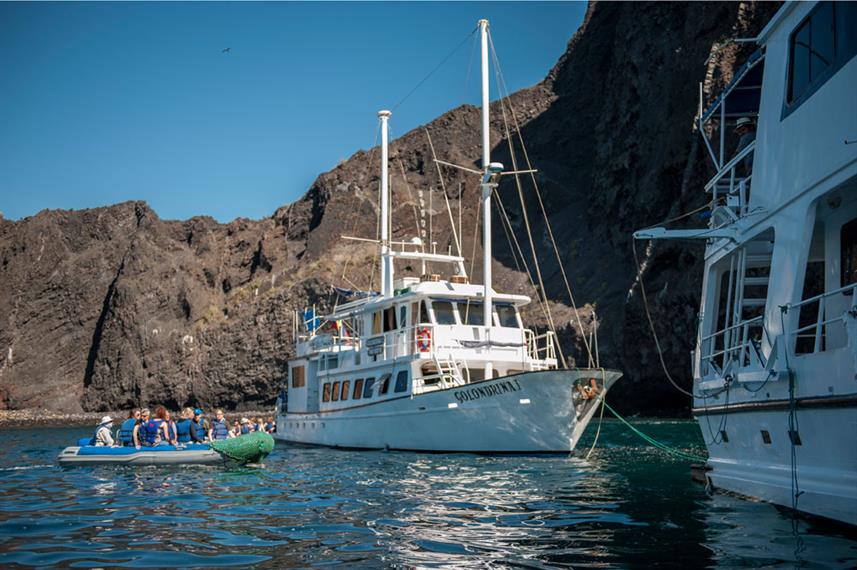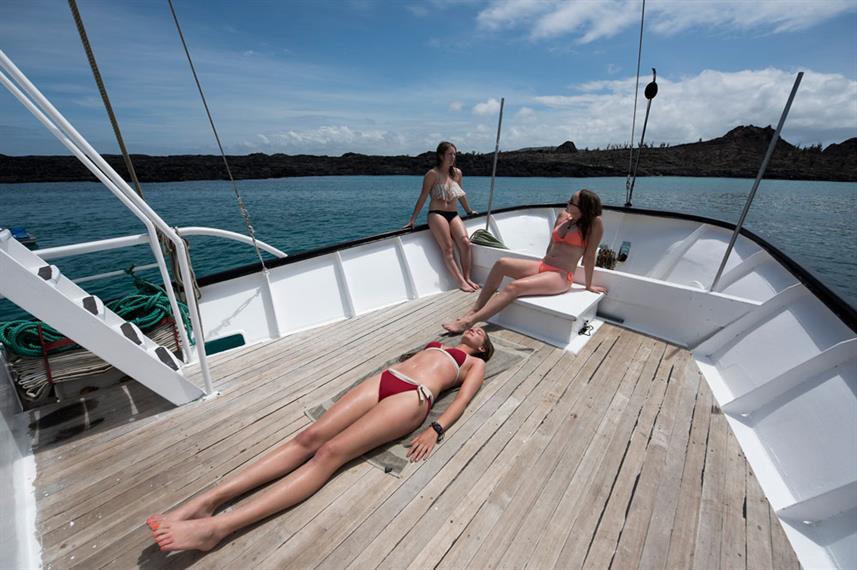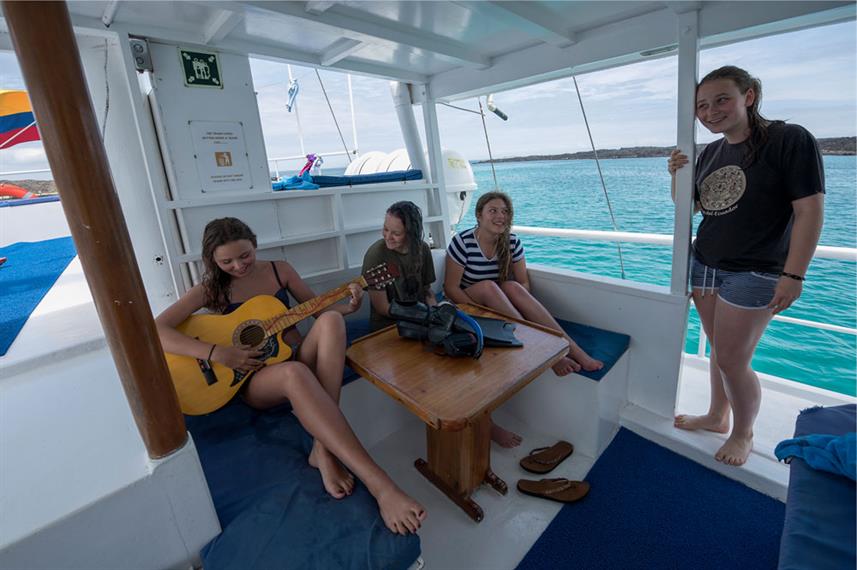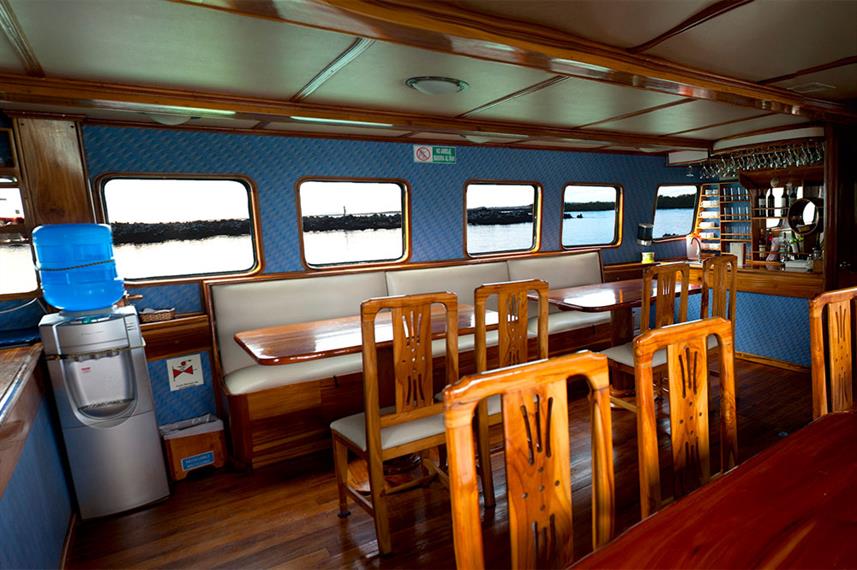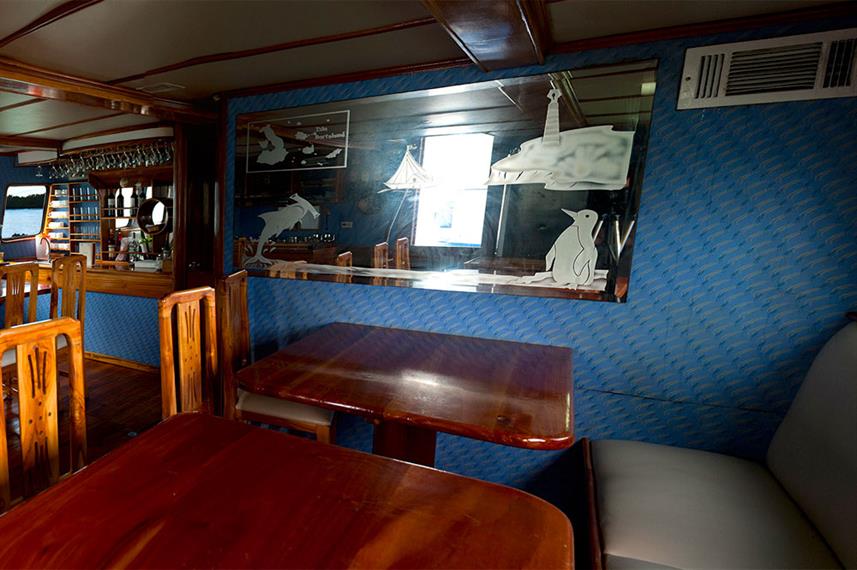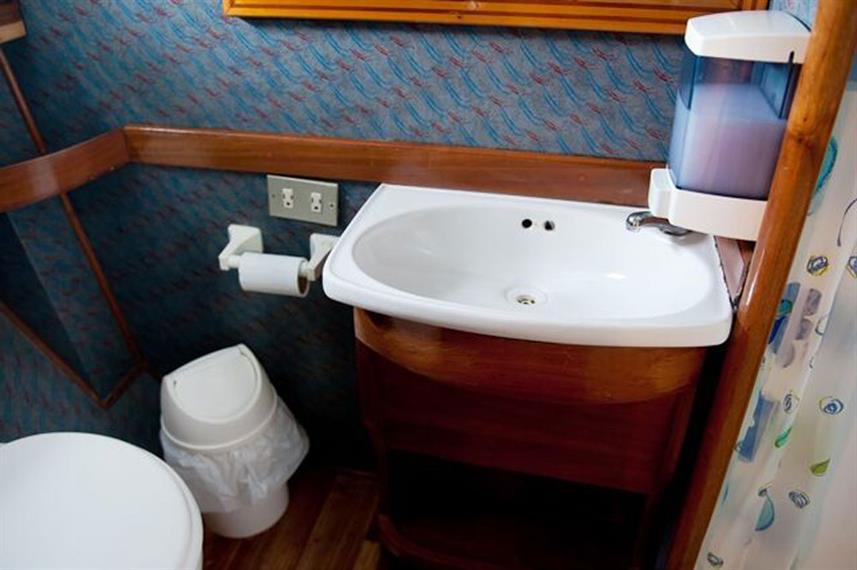GOLONDRINA YACHT
Join the Golondrina yacht for an exciting small-ship cruise in the Galapagos Islands. Catering to just 16 guests, she offers attention to detail, a relaxing atmosphere and personalized service. Eight twin bunk-bed cabins are available, each carpeted with en-suite bathrooms, hot water showers and AC. Social areas include a comfortable dining room where local freshly prepared dishes are served a la carte style, indoor salon and bar with entertainment facilities and sun-deck perfect for relaxing in-between activities.
The Golondrina yacht offers 5 and 8-day itineraries which are designed so that guests experience the best of the Galapagos Islands and the incredible wildlife diversity. Snorkel with sea lions and penguins, swim with turtles and rays and hike to spectacular panoramic viewpoints. Itineraries can also be combined back to back to really see everything the Galapagos has to offer.
RESERVE THIS CRUISE
Starting Price Per Person: $2.749,00 USD, all taxes are included.
Please confirm availability for your desired itinerary by contacting us at:
info@galapagosbestoption.com / sales@galapagosbestoption.com / Whatsapp +593 967742545
PAYMENT POLICY
To book and confirm any tour, we must receive 100% of the total amount prior to the tour as follows:
50% due at the time of booking
50% due two weeks before the date of your tour
CANCELLATIONS
Any last minute cancellations or changes by the customer may incur a fee to be imposed by Galapagos Best Option SA.
If for any reason a passenger is not present at the time of their flight they will be considered a no show and will not be subject to any refund by the agency.
Please read our full Cancellation and Refund Policy.
The Galapagos National Park has the right to make any changes to the itinerary due to natural disasters or scientific research projects.
ITINERARY C
8 DAYS
Day 1 (Friday): BALTRA – BACHAS BEACH
AM
- Depart from Guayaquil to Galápagos (1½ hours of flight time).
- BALTRA ISLAND: This Island was a strategic point during the Second World War. This beautiful Island is located at the main airport of the Galapagos Islands where tourists and colonists arrive and depart. When arriving at Baltra Airport, our naturalist English speaking guide will assist you.
PM
- BACHAS BEACH: After lunch, we'll land at Bachas Beach located in the North Shore of Santa Cruz. It is one of the main nesting places for sea turtles, and the crystal waters invite you to relax and swim. After visiting Bachas, we'll bring you back to the yacht, you'll have dinner and you'll get ready for a new adventure.
Day 2 (Saturday): GENOVESA ISLAND
AM
- EL BARRANCO: Also known as Prince Phillip's Steps, El Barranco’s steep, rocky paths lead up to a high cliff-face. A marvelous view can be appreciated from here. This site is also home to Palo Santo vegetation as well as Red-footed Boobies, Short-eared Lava Owls, Galapagos Swallows storm-petrels and Galapagos Doves. Hiking: 2km., dry landing. Lunch on board.
PM
- DARWIN BAY: This enormous bay dominates the island, and like the Prince Philip's Steps, this place is home to a wide variety of seabirds including the famous frigates. Briefing and dinner on board.
Day 3 (Sunday): BARTOLOME – SANTIAGO
AM
- BARTOLOME: Lava formations and ash cones can be seen on this Island. A beautiful view of the nearest bays is waiting at the high part, after climbing a wood staircase for 30 to 40 minutes to the top (Walk up to the top of volcano 114 meters, 375 wooden steps). This is one of the most visited Islands because of its unique and famous Pinnacle Rock that consists of an extinct volcano with a variety of red, orange, black and even green volcanic formations. Time for snorkeling and possible sightings of the Galapagos Penguin. Hiking: 2kms. Dry and wet landings.
PM
- SULLIVAN BAY (SANTIAGO ISLAND): You can swim and snorkel here with seals and penguins. The landing takes place on a beautiful white sand beach where you can see some lava formations. Wet landing. Briefing and dinner on board.
Day 4 (Monday): SOUTH PLAZAS ISLAND – SANTA FE ISLAND
AM
- PLAZAS ISLAND: This small island with steep cliffs was formed by rising lava and is now covered by Opuntia cacti. This Island is home to one of the largest Sea Lion colonies as well as colorful yellow and red land Iguanas. Many birds like the Tropicbirds and Fork-Tailed Seagulls rest on the cliffs. The most characteristic plant is the Sesuvium, during the rainy season its color is a greenish to yellowish tone and in the dry season (end of June through January) a bright red. Hike: 2 ½ km. Dry landing. Lunch on board.
PM
- SANTA FE: Colonies of sea lions, land iguanas, fork-tailed seagulls, terns and petrels can be observed. A trail will take you into the heart of the island where you can see a forest of giant cactus and palo santo trees. After this visit on land, you can swim and snorkel. Wet landing. Briefing and dinner on board.
Day 5 (Tuesday): SAN CRISTOBAL ISLAND – LOBOS ISLAND
AM
- LEON DORMIDO: After breakfast, we'll visit Kicker Rock, a giant rock that was formed by a volcanic eruption. A narrow canal right across Leon Dormido allows the transportation of small boats. On the other hand, this rock is home to many seabirds and is considered a great snorkeling and diving site. No landing.
- CERRO BRUJO: This site is located on the north shore of San Cristobal Island. This eroded hill and its surroundings present one of the most picturesque beaches in the Galapagos with its main attraction that is the coral sand beach and its wildlife includes Sea Turtles, Rays, and various types of Booby Birds. Lunch on board.
PM
- LOBOS ISLAND: The most important colony of Sea Lions and Blue-Footed Boobies is on this Island. The scenery is beautiful and it is the perfect spot to snorkel. Briefing and dinner on board. Return to the yacht. Dinner and briefing for next day.
Day 6 (Wednesday): ESPAÑOLA ISLAND
AM
- SUAREZ POINT: Breakfast. This natural place is home to blue-footed boobies, masked boobies, colonies of marine iguanas, fascinating albatross, sea lions, Galapagos doves, and Darwin finches. Nevertheless, there is another natural attraction: the lava blowhole, where you'll be able to see water spurting into the air. Hike: 3km. Dry landing. Lunch on board.
PM
- GARDNER BAY: On the eastern side of the island, is the breeding site of nearly all of the world´s 12,000 pairs of Waved Albatrosses. It takes 45 minutes by boat to reach this site. The white sand beach is home to a group of Sea Lions. Swimming and snorkeling are excellent possibilities here. Wet landing.
- GARDNER ISLET: Sea Lions, Marine Turtles, and Finches can be seen here.
- OSBORN ISLET: This small island is located southeast of Española. In Osborn Islet you'll be able to do some snorkeling and swimming. Dinner and briefing for the next day.
Day 7 (Thursday): FLOREANA ISLAND – SANTA CRUZ ISLAND
AM
- CORMORANT POINT: Breakfast. This site hosts a large Flamingo lagoon where other birds such as common Stilts, White-cheeked Pintails can also be seen. Olivine crystals in the beach make to name as the Green Beach. To the other side of the island, there is a very fine white sand beach where marine turtles nest from December to May. Hike: 2km. Wet landing.
- DEVIL’S CROWN: This volcanic crater has been eroded by the waves leaving the northern and southern sides poking out of the water. The coral formations make the underwater scenery impressive for snorkelers where there are schools of multi-colored fish, Sharks and Sea Turtles. No Landing.
PM
- CHARLES DARWIN STATION (SANTA CRUZ ISLAND): The Darwin Station is part of the Charles Darwin Foundation for the Galápagos Islands, an international non-profit organization dedicated to scientific research in the Galápagos Islands since 1959. This visit offers an excellent introduction to the Islands, their origin and their formation. Learn about the Galapagos Giant Turtles breeding. Dinner and briefing for next day.
Day 8 (Friday): SEYMOUR ISLAND – BALTRA AIRPORT
AM
- NORTH SEYMOUR ISLAND: This Island is known for its large number of blue-footed boobies, colonies of magnificent frigate birds, fork-tailed seagulls, marine iguanas and sea lions. This island is characterized by its arid vegetation zone, being Palo Santo – Lignum Vitae - the most remarkable tree on the island. This is the end of the trip.
- This is the end of the trip.
PRICE : 3.219,00 USD P.P.
ITINERRY B
5 DAYS
Day 1 (Friday): Baltra - Mosquera
AM: Depart from Guayaquil to Galápagos (1½ hours of flight time).
BALTRA ISLAND: This Island was a strategic point during the Second World War. This beautiful Island is located at the main airport of the Galapagos Islands where tourists and colonists arrive and depart. When arriving at Baltra Airport, our naturalist English speaking guide will assist you.
PM
MOSQUERA: After lunch, we'll land at Mosquera Island located between North Seymour and Baltra. The island consists of a long narrow stretch of white sand, rocks, and tide pools. It was formed by geological uplift. For this reason, the island has a flat look, rather than the conical shape of the volcanically formed islands. Additionally, it is a great place for snorkeling, strolling on the beach, and enjoying the natural life without the crowds commonly seen in many other popular islands. This island is not only home to a lion, but also the home of many shorebirds.
Briefing and dinner on board.
Day 2 (Saturday): Isabela Island - Fernandina Island
AM
VICENTE ROCA POINT (ISABELA ISLAND): After breakfast, panga ride visit to Vicente Roca Point. Comprised of two separate coves, this site is a large bay with spectacular sea life, observing seahorses, sea turtles, rays, puffer fish, the strange yet fascinating Mola-mola (or sunfish), we see also penguins, blue-footed boobies, and Nazca boobies. Lunch on board.
PM
ESPINOZA POINT (FERNANDINA ISLAND): In the afternoon disembarkation (dry landing). Walk (600m. round trip, 1½h, flat, sandy and rocky path) to see lava flows, a colony of marine iguanas (nesting time: January to June), penguins, pelicans and colonies of cormorants, lava cactus. Time for snorkeling. Briefing and dinner on board.
Day 3 (Sunday): Isabela Island
AM
ISABELA (URBINA BAY): After breakfast, we'll land at Urbina Bay (wet landing), located west of Isabela Island, at the foothills of the Alcedo volcano. Minutes later, we'll walk on a sandy and rocky defined path (1 km. round trip. 2h, flat), observing calcareous organisms such as shells and corals exposed above water. In this area, you'll also have the opportunity to see a large colony of land iguanas, Darwin's finches, giant tortoises (between June – September), and flightless cormorants. After hiking, we may have time for snorkeling along the shoreline where guests may observe penguins and flightless cormorants.
PM
TAGUS COVE (ISABELA ISLAND): After lunch visit to Tagus Cove that was a port where whaling ships arrived and left their ships’ names in a cave in 1800. In the high part is the Darwin Lake, a round salt water crater. Disembark (dry landing). The walk begins from the shore by a wooden stairway that rises to the dusty trail passing through Palo Santo Forest to reach the Darwin Lake. Continue on the trail around the lake through the dry vegetation zone. Panoramic views of the Darwin and Wolf volcanoes. (2kms round trip, 2h / starts at 0m, ascending to 50mts). Later, panga ride through the cliffs to observe the historical graffiti, penguins, flightless cormorants, boobies, pelicans and Sally Lightfoot crabs. Snorkeling time in the cove. Briefing and dinner on board.
Day 4 (Monday): Santiago Island
AM
EGAS PORT: Breakfast. The visit to Puerto Egas begins with a wet landing on the dark sand beach of James Bay. Walk along a rocky trail to the salt crater (1.7km. round trip, 1½ h, start at 0m, ascend 30m), observing Darwin Finches, the endemic Galapagos hawks, marine iguanas, sally lightfoot crabs and fur seals and sea lions. Time for swimming and snorkeling.
PM
SOMBRERO CHINO: After lunch, disembark (wet landing) for a short walk of 200m. (30mins. round trip, flat and rocky), observing lava tunnels, lava cactus, Galápagos Sesuvium. Time to swim and snorkel. Return to the yacht. Dinner and briefing for the next day.
Day 5 (Tuesday): Santa Cruz Island - Baltra
AM
SANTA CRUZ ISLAND (CHARLES DARWIN RESEARCH STATION): After breakfast, walk for about 20 minutes to the Charles Darwin Station, to observe the Galapagos giant turtles breading. The Darwin Station is part of the Charles Darwin Foundation for the Galápagos Islands, an international non-profit organization dedicated to scientific research in the Galápagos Islands since 1959. After this visit transfer to Baltra Airport by bus for your return flight to Guayaquil.
This is the end of the trip.
Our very flexible itineraries of 4, 5, or 8 days are perfectly designed for passengers to experience the diversity and uniqueness of the Galapagos Islands in a small, familiar environment. We offer daily complimentary activities including trekking, swimming, and snorkeling, and transportation to visitor sites on small dinghy boats (pangas) is also included and pre-arranged. The Fragata Yacht may be chartered for specialty cruises, and we can accommodate a large variety of groups including student, academic, family, executive, and more. We look forward to the great pleasure and honor to welcome you onboard and discover this wonderful paradise with us!
PRICE : 1.949,00 USD P.P.
ITINERARY D
8 DAYS
Day 1 (Friday): BALTRA – MOSQUERA
AM
- Depart from Guayaquil to Galápagos (1½ hours of flight time).
- BALTRA ISLAND: This Island was a strategic point during the Second World War. This beautiful Island is located at the main airport of the Galapagos Islands where tourists and colonists arrive and depart. When arriving at Baltra Airport, our naturalist English speaking guide will assist you.
PM
- MOSQUERA: After lunch, we'll land at Mosquera Island located between North Seymour and Baltra. The island consists of a long narrow stretch of white sand, rocks, and tide pools. It was formed by geological uplift. For this reason, the island has a flat look, rather than the conical shape of the volcanically formed islands. Additionally, it is a great place for snorkeling, strolling on the beach, and enjoying the natural life without the crowds commonly seen on many other popular islands. This island is not only home to a huge population of sea lions, but also the home of many shorebirds.
Day 2 (Saturday): ISABELA ISLAND – FERNANDINA ISLAND
AM
- VICENTE ROCA POINT (ISABELA ISLAND): After breakfast, you'll be carried by panga to Vicente Roca Point. It consists of two separated coves and has a spectacular bay characterized by an unbelievable array of sea life. You’ll have the opportunity to see seahorses, sea turtles, rays, pufferfishes, sunfishes, Galapagos penguins, blue-footed boobies, and the Nazca Boobies.
PM
- ESPINOZA POINT (FERNANDINA ISLAND): In the afternoon disembarkation (dry landing). Walk (600m. round trip, 1½h, flat, sandy and rocky path) to see Lava Flows, a colony of Marine Iguanas (nesting time: January to June), Penguins, Pelicans and colonies of Cormorants, Lava Cactus. Time for snorkeling. Briefing and dinner on board.
Day 3 (Sunday): ISABELA ISLAND
AM
- URBINA BAY (ISABELA ISLAND): After breakfast, we'll land at Urbina Bay (wet landing), located west of Isabela Island, at the foothills of the Alcedo volcano. Minutes later, we'll walk on a sandy and rocky defined path (1 km. round trip. 2h, flat), observing calcareous organisms such as shells and corals exposed above water. In this area, you'll also have the opportunity to see a large colony of land iguanas, Darwin's finches, giant tortoises (between June – September), and flightless cormorants. After hiking, we may have time for snorkeling along the shoreline where guests may observe penguins and flightless cormorants.
PM
- TAGUS COVE (ISABELA ISLAND): After lunch visit Tagus Cove that was a port where whaling ships arrived and left their ships’ names in a cave in 1800. In the high part is Darwin Lake, a round saltwater crater. Disembark (dry landing). The walk begins from the shore by a wooden stairway that rises to the dusty trail passing through Palo Santo Forest to reach Darwin Lake. Continue on the trail around the lake through the dry vegetation zone. Panoramic views to the Darwin and Wolf volcanoes. (2kms round trip, 2h / starts at 0m, ascending to 50mts). Later, panga ride through the cliffs to observe the historical graffiti, Penguins, Flightless Cormorants, Boobies, Pelicans, and Sally Lightfoot Crabs. Snorkeling time in the cove. Briefing and dinner on board.
Day 4 (Monday): SANTIAGO ISLAND
AM
- EGAS PORT: Breakfast. The visit to Puerto Egas begins with a wet landing on the dark sand beach of James Bay. Walk along a rocky trail to the salt crater (1.7km. round trip, 1½ h, start at 0m, ascend 30m), observing Darwin Finches, the endemic Galapagos Hawks, Marine Iguanas, Sally Light Root Crabs, and Fur Seals and Sea Lions. Time for swimming and snorkeling.
PM
- SOMBRERO CHINO: After lunch, disembark (wet landing) for a short walk of 200m. (30mins. round trip, flat and rocky), observing lava tunnels, lava cactus, Galápagos Sesuvium. Time to swim and snorkel. Return to the yacht. Dinner and briefing for the next day.
Day 5 (Tuesday): SANTA CRUZ ISLAND – BALTRA
AM
- CHARLES DARWIN RESEARCH STATION (SANTA CRUZ ISLAND): After breakfast, walk for about 20 minutes to the Charles Darwin Station, to observe the Galapagos turtles breading. The Darwin Station is part of the Charles Darwin Foundation for the Galápagos Islands, an international non-profit organization dedicated to scientific research in the Galápagos Islands since 1959.
PM
- HACIENDA PRIMICIAS: After lunch, you'll have the chance to visit Hacienda Primicias, and see the giant tortoises in their natural habitat. The tortoises are easy to find, they're always eating in the exuberant green grass. Furthermore, you'll also have the opportunity to see some cattle egrets, mockingbirds, and finches. After the hiking, we'll bring you back to the yacht, you'll have dinner and you'll get ready for a new adventure.
Day 6 (Wednesday): ISABELA ISLAND
AM
- TINTORERAS: After breakfast, Las Tintoreras is located south of Puerto Villamil. It has a small bay of completely calm turquoise waters, where you can appreciate sea lions, sea turtles, marine iguanas, rays, etc. The bay is connected to a crevice of crystal clear water, that's shallow and when the tide is low, the entrance closes. In this crevice, you can see how reef sharks swim along with other small fish and Sea Lions. Lunch on board.
PM
- BREEDING CENTER ARNALDO TUPIZA: This center has a captive breeding program for Tortoises from the populations of southern Isabela.
- HUMEDALES: Disembark (dry landing), walk for about 30 mins. This area is characterized by sandy beaches, rocky shores, and mangroves. The area has a number of trails where you can see all four species of mangroves found in Galapagos and also migratory birds: Whimbrel, Short-Billed Dowitcher, Wilson’s Phalarope, Common Tern, Blue-Winged Teal, Osprey, Black-Bellied and Semipalmated Plovers, Greater and Lesser Yellowlegs to name a few.
- WALL OF TEARS: By bus to Wall of tears a sad reminder of the history of Isabela. The wall was constructed between 1946 and 1959 while Isabela was a penal colony. As punishment, the prisoners were forced to build the wall from huge blocks of lava. The wall is named for the many convicts that died while building the wall. Dinner and briefing for the next day.
Day 7 (Thursday): RABIDA ISLAND – SANTA CRUZ ISLAND
AM
- RABIDA: After breakfast disembark (wet landing) in one of the most colorful and volcanically varied islands in the archipelago as well as a great snorkeling site. We will start at Rabida's famous maroon sandy beach and after an easy hike (1 km approx) will arrive at a stunning lookout to enjoy the amazing landscapes. The island is a birdwatcher's delight. Some of the rarest species are in abundance, such as nine varieties of Finches, Large-billed Flycatchers, Galapagos Hawks and Brown Pelicans.
PM
- CERRO DRAGON: After lunch, dry landing at a dock, the walk takes you to a hypersalinic (saltier than the ocean) lagoon behind the beach, often frequented by Flamingos, Common Stilts, Pintail Ducks and other species of birds. There is a short walk to the hill, which rewards with a great view of the bay and a nesting site of land Iguanas. Many of the Iguanas that nest here have been repatriated by the Charles Darwin Research Station. Dinner and briefing for the next day.
Day 8 (Friday): SANTA CRUZ ISLAND
AM
- BLACK TURTLE COVE: After breakfast, you'll be carried by dinghy (panga) to Black Turtle Bay (Caleta Tortuga Negra), located near Baltra. This place is characterized by its lovely beach that houses incredible animals such as the sea lions in the Galapagos' crystalline waters. Nevertheless, it can also be seen in some species of birds feeding around the beautiful lagoons hidden in the mangroves. After this visit, you'll be transported to Baltra Airport for your return to Guayaquil / Quito.
- This is the end of the trip.
PRICE : 3.199,00 USD
ITINERARY H
5 DAYS
Day 1 (Monday): SANTA CRUZ ISLAND
AM: Depart from Guayaquil to Galápagos (1½ hours of flight time).
BALTRA ISLAND: This Island was a strategic point during the Second World War. This beautiful Island is located at the main airport of the Galapagos Islands where tourists and colonists arrive and depart. When arriving at Baltra Airport, our naturalist English speaking guide will assist you.
PM
TORTUGA BAY BEACH: After lunch, visit Tortuga Bay Beach a pristine location covered with the beautiful white sand beach. It takes around an hour to walk to the beach. Beautiful birds including the famous Galapagos Finches can be admired. The trail to the beach is paved and marked. There are two beaches at Tortuga Bay, the main beach is used for surfing due to its strong waves. There is a site where the sea is calm. After this visit, you can enjoy the attractions of the nightlife offered by the Island. Accommodation and dinner at Hotel Fernandina or similar.
Day 2 (Tuesday): SANTA CRUZ ISLAND
AM
CHARLES DARWIN RESEARCH STATION: After breakfast, walk for about 20 mins. to the Charles Darwin Station, to observe the Galapagos Giant Turtles breading. The Darwin Station is part of the Charles Darwin Foundation for the Galápagos Islands, an international non-profit organization dedicated to scientific research in the Galápagos Islands since 1959.
PM
HACIENDA PRIMICIAS: After lunch, you'll have the chance to visit Hacienda Primicias, and see the giant tortoises in their natural habitat. The tortoises are easy to find, they're always eating in the exuberant green grass. Furthermore, you'll also have the opportunity to see some cattle egrets, mockingbirds, and finches. After the hiking, we'll bring you back to the yacht, you'll have dinner and you'll get ready for a new adventure.
Day 3 (Wednesday): ISABELA ISLAND
AM
TINTORERAS: After breakfast, Tintoreras is located south of Puerto Villamil. It has a small bay of completely calm Turquoise waters, where you can appreciate Sea Lions, Sea Turtles, Marine Iguanas, Rays, etc. The bay is connected to a crevice of crystal clear water, that's shallow and when the tide is low, the entrance closes. In this crevice, you can see how Reef Sharks swim along with other small fish and Sea Lions. Lunch on board.
PM
BREEDING CENTER ARNALDO TUPIZA: This center has a captive breeding program for Tortoises from the populations of southern Isabela.
HUMEDALES: Disembark (dry landing), walk for about 30 mins. This area is characterized by sandy beaches, rocky shores, and mangroves. The area has a number of trails where you can see all four species of mangroves found in Galapagos and also migratory birds: Whimbrel, Short-billed Dowitcher, Wilson’s Phalarope, Common Tern, Blue-winged Teal, Osprey, Black-bellied and Semipalmated Plovers, Greater and Lesser Yellowlegs to name a few.
WALL OF TEARS: By bus to Wall of tears a sad reminder of the history of Isabela. The wall was constructed between 1946 and 1959 while Isabela was a penal colony. As punishment, the prisoners were forced to build the wall from huge blocks of lava. The wall is named for the many convicts that died while building the wall. Dinner and briefing for the next day.
Day 4 (Thursday): RABIDA ISLAND - SANTA CRUZ ISLAND
AM
RABIDA: After breakfast disembark (wet landing) in one of the most colorful and volcanically varied islands in the archipelago as well as a great snorkeling site. We will start at Rabida's famous maroon sandy beach and after an easy hike (1 km approx) will arrive at a stunning lookout to enjoy the amazing landscapes.
The island is a birdwatcher's delight. Some of the rarest species are in abundance, such as nine varieties of Finches, Large-billed Flycatchers, Galapagos Hawks and Brown Pelicans.
PM
CERRO DRAGON: After lunch, dry landing at a deck, the walk takes you to a hypersalinic (saltier than the ocean) lagoon behind the beach, often frequented by Flamingos, Common Stilts, Pintail Ducks and other species of birds. There is a short walk to the hill, which rewards with a great view of the bay and a resting site of land Iguanas. Many of the Iguanas that rest here have been repatriated by the Charles Darwin Research Station. Dinner and briefing for the next day.
Day 5 (Friday): SANTA CRUZ ISLAND
AM
BLACK TURTLE COVE: After breakfast, you'll be carried by dinghy (panga) to Black Turtle Bay (Caleta Tortuga Negra), located near to Baltra. This place is characterized by its lovely beach that houses incredible animals such as the sea lions in the Galapagos' crystalline waters. Nevertheless, it can also be seen in some species of birds feeding around the beautiful lagoons hidden in the mangroves.
After this visit, you'll be transported to Baltra Airport for your return to Guayaquil / Quito.
PRICE : 1.949,00 USD P.P.
- Airport Transfers
- Naturalist Guide Certified by the Galapagos National Park
- Full Meals
- Coffee, Tea and Snacks
- Snorkel Gear (Mask, Fins and Snorkel)
- Wetsuit
- Private Bathroom With Hot Water
- Air Conditioning
- Entrance Fee to Galapagos National Park $100 USD
- Immigration Control Card $20 USD
- Personal Expenses
- Tips for the Crew and Guide
- Galapagos Flights ($450 to $550 USD – ask us for a quote!)
- Alcoholic Beverages and Soft Drinks

